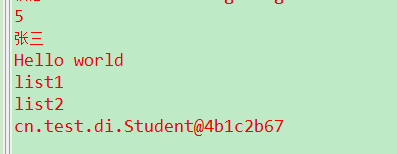Person.java
public class Person { private Long pid; private String pname; private Student student; private List list; private Set set; private Map map; private Properties properties; //get和set方法 }
applicationContext.xml
1 <?xml version="1.0" encoding="UTF-8"?> 2 <beans xmlns="http://www.springframework.org/schema/beans" 3 xmlns:xsi="http://www.w3.org/2001/XMLSchema-instance" 4 xsi:schemaLocation="http://www.springframework.org/schema/beans 5 http://www.springframework.org/schema/beans/spring-beans-2.5.xsd"> 6 7 <bean name="person" class="cn.test.di.Person"> 8 <!-- 9 property就是代表属性 10 在spring中基本类型(包装类型和String)都可以用value来赋值 11 引用类型用ref赋值 12 --> 13 <property name="pid" value="5"></property> 14 <property name="pname" value="张三"></property><!-- 基本数据类型 --> 15 <property name="student" ref="student"></property><!-- 引用类型 --> 16 <property name="list"> 17 <list> 18 <value>list1</value> 19 <value>list2</value> 20 <ref bean="student"/> 21 </list> 22 </property> 23 24 <property name="set"> 25 <set> 26 <value>set1</value> 27 <value>set2</value> 28 <ref bean="student"/> 29 </set> 30 </property> 31 <property name="map"> 32 <map> 33 <entry key="map1"> 34 <value>map1</value> 35 </entry> 36 <entry key="map2"> 37 <value>map2</value> 38 </entry> 39 <entry key="map3"> 40 <ref bean="student"/> 41 </entry> 42 </map> 43 </property> 44 <property name="properties"> 45 <props> 46 <prop key="pro1"> 47 pro1 48 </prop> 49 </props> 50 </property> 51 </bean> 52 <bean name="student" class="cn.test.di.Student"></bean> 53 </beans>
测试
1 @Test 2 public void doSome(){ 3 ApplicationContext applicationContext=new ClassPathXmlApplicationContext("cn/test/di/applicationContext.xml"); 4 Person person= (Person) applicationContext.getBean("person"); 5 System.err.println(person.getPid()); 6 System.err.println(person.getPname()); 7 person.getStudent().say(); 8 List list=person.getList(); 9 for(int i=0;i<list.size();i++){ 10 System.err.println(list.get(i).toString()); 11 }

处理使用上面的get方法进行赋值外,还可以通过构造函数来赋值,首先在类中添加构造函数,然后进行配置
public Person(String pname, Student student) { this.pname = pname; this.student = student; }
1 <!-- 2 构造函数的参数 3 index 第几个参数,下标从0开始 4 type 参数的类型 5 ref 如果类型是引用类型,赋值 6 value 如果类型是基本类型,赋值 7 说明: 8 只能指定一个构造函数 9 --> 10 <constructor-arg index="0" type="java.lang.String" value="李四"></constructor-arg> 11 <constructor-arg index="1" type="cn.test.di2.Student" ref="student"></constructor-arg>
1 @Test 2 public void doSome(){ 3 ApplicationContext applicationContext=new ClassPathXmlApplicationContext("cn/test/di2/applicationContext.xml"); 4 Person person= (Person) applicationContext.getBean("person"); 5 System.err.println(person.getPname()); 6 person.getStudent().say(); 7 }
